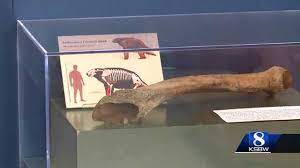SANTA CRUZ, Calif. — A group of students discovered something that’s never been found in Santa Cruz County before. A fossil of the Jefferson’s Ground Sloth, an animal that paleontologists had no idea was in this area of the state until a few curious kids unearthed it.
“They were building a dam, looking for crawdads,” said Bryn Evans, a teacher who was with the students when they found the fossil. “They’re just in the mud pulling things out and then one of them comes up and is like, ‘This isn’t a stick, this is a bone!’” What the Tara Redwood School students discovered was a radius bone of the ground sloth.
The animal is named in honor of the third United States President Thomas Jefferson. Jefferson documented fossil bones he found of this animal in West Virginia in the late 1700s. In fact, the first two scientific articles ever published in the country on fossils were about this herbivore. Jefferson ended up carrying the fossils with him to Philadelphia.

“It’s part of Americana really,” described Wayne Thompson, a paleontologist. “He brought the bones of Thomas Jefferson’s ground sloth to Philadelphia, he carried them with him when went to accept the vice presidency.” The average size for these herbivores was around one and a half tons and about the size of an Ox. Thompson says it may be one of the largest known radius bones ever found of this creature and it just so happened to be found by a group of youngsters in the Santa Cruz mountains. “We are so thrilled that young students were the ones who discovered this fossil,” said Felicia Van Stolk, who’s the executive director of the Santa Cruz Museum of Natural History – where the fossil will be on display. “It’s art of the museum’s history to have young naturalists, young people who are interested in looking at nature, exploring and collecting.”
With only one bone found, the job isn’t finished for the rest of the youngsters, who say they’re going to go back and look for the rest of the skeleton.
The display will be open to the public starting Friday in the Art of Nature exhibit. It will stay up until the end of May.



